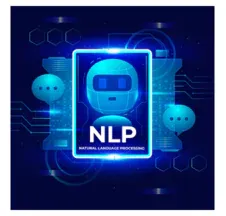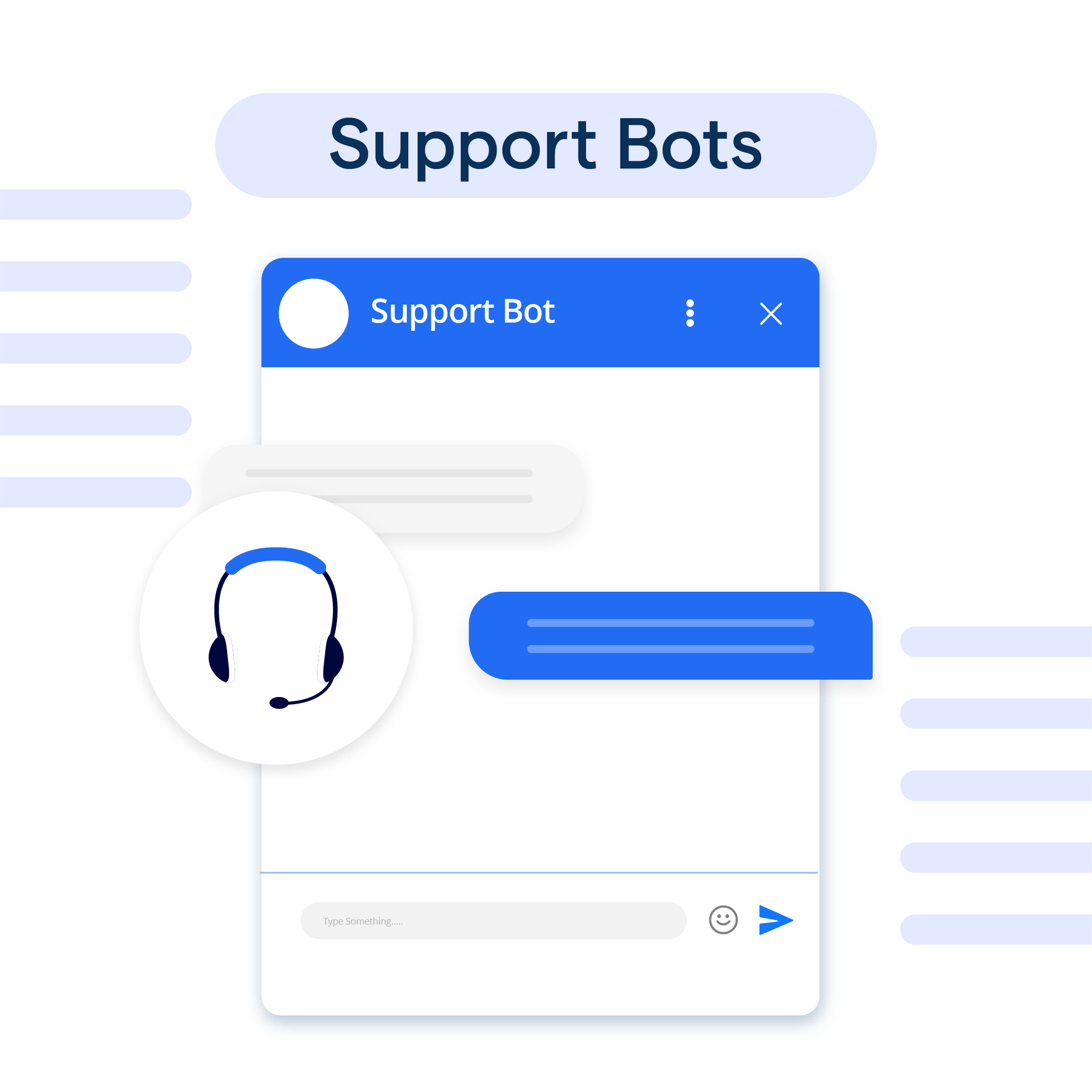What are Support Bots?

Support bots, also known as chatbots, are virtual assistants designed to help users with their questions or issues. They use artificial intelligence to understand and respond to text or voice inputs, making them super handy for customer support.
They can handle common queries, guide users through processes, and even escalate issues to human support when needed. Support bots are a convenient and efficient way to offer 24/7 assistance to customers without overloading your support team.
Types of Support Bots
FAQ Bots: These bots are great at helping users find answers to frequently asked questions.
Virtual Assistants: Think Siri or Alexa, but for businesses. They can help with tasks such as scheduling meetings or answering calls.
Social Media Bots: These bots monitor and engage with customers on social media platforms.
Why Use Support Bots?
Faster Response Times
Support bots are like lightning-fast customer service ninjas, providing instant responses to customer inquiries. With their speedy assistance, customers won't be left waiting, and their issues can be resolved quickly.
Cost-Effective Solution
Support bots are like having a whole team of customer service agents, but without the added expenses of salaries and benefits. They help businesses save money while still providing high-quality support to their customers.
24/7 Availability
Support bots are always awake and ready to help, no matter the time of day or night. This round-the-clock assistance ensures that customers can get the help they need whenever they need it.
Consistent Customer Experience
Support bots are like well-trained customer service agents who always follow the script. They provide a consistent customer experience, ensuring that every interaction with your brand is up to your high standards.
Multitasking Masters
Support bots can juggle multiple conversations at once, like a skilled juggler at a circus. This multitasking ability allows them to assist numerous customers simultaneously, reducing wait times and increasing overall efficiency.
Easy Scalability
Support bots can grow with your business without breaking a sweat. As your customer base expands, your support bot can effortlessly handle the increased volume of inquiries, ensuring that every customer receives the attention they deserve.
Language Capabilities
Support bots can be multilingual maestros, speaking multiple languages and helping customers from diverse backgrounds. This language versatility makes your customer support more inclusive and accessible to a wider audience.
Valuable Data Collection
Support bots are like secret agents, collecting valuable data and insights during their interactions with customers. This information can be used to improve your products, services, and overall customer experience, making your business even better over time.
When to Implement Support Bots?
Identifying the Need for Automation
If you're experiencing any of these issues, support bots might be just what the doctor ordered:
High customer support costs.
Long wait times and dissatisfied customers.
Repetitive and time-consuming tasks for support agents.
Key Indicators for Support Bot Adoption
Keep an eye out for these signs that your business is ready for support bots:
A high volume of recurring customer queries.
An expanding customer base that's becoming hard to manage.
The need for round-the-clock support.
Phased Implementation Approach
Rome wasn't built in a day, and neither is a support bot strategy. Consider a phased approach:
Start small, with a bot that addresses a specific problem or need.
Monitor and measure its effectiveness.
Gradually expand the bot's capabilities and roles as needed.
Where are Support Bots the Most Effective?
Common Use Cases for Support Bots
Support bots can tackle a wide array of tasks, but they're especially effective in:
Customer support: Answering questions and resolving issues in a jiffy.
Sales and marketing: Guiding customers through product discovery and purchase.
Onboarding: Helping new users navigate apps, websites, or software.
Internal support: Assisting employees with IT issues, HR questions, and more.
Channels for Support Bot Deployment
Websites and apps: Providing live chat assistance.
Social media: Responding to comments and messages.
Messaging apps: Chatting via WhatsApp, Facebook Messenger, and more.
Voice Assistants: Answering questions through devices like Amazon Echo or Google Home.
Integration with Existing Systems
CRM systems: Syncing customer data for a personalized experience.
Helpdesk software: Streamlining ticket creation and resolution.
Analytics tools: Collecting data to inform business decisions.
How do Support Bots Work?
Step 1
Understanding Natural Language Processing (NLP)

NLP is the magic that helps support bots understand and respond to human language by:
Identifying keywords and phrases.
Analyzing sentence structure and context.
Generating relevant and helpful responses.
Step 2
Machine Learning and Support Bot Training
Support bots are like sponges—they learn from experience! Machine learning enables them to:
Adapt and improve their responses over time.
Recognize patterns in customer interactions.
Predict user needs and offer proactive assistance.
Step 3
Personalization and Contextual Understanding
Nobody likes talking to a robot, right? Support bots strive to offer personalized and contextually-aware interactions by:
Remembering previous conversations and user preferences.
Tailoring responses based on user behavior and data.
Offering relevant suggestions and solutions.
Best Practices for Support Bot Deployment
Understand Your Audience
Before deploying your support bot, get to know your audience like they're your best friends! Research their needs, preferences, and common issues to make sure your bot is equipped to handle their inquiries effectively. The more your bot understands your customers, the better it can assist them, making them feel like they're chatting with a helpful buddy.
Keep It Simple and User-Friendly
Nobody likes a complicated conversation, especially with a support bot. Make sure your bot's interface is easy to navigate and its language is clear and concise. A user-friendly bot will feel like a warm, welcoming guide, ready to help customers through their concerns.
Train Your Bot to Be a Smarty-Pants
An effective support bot should be knowledgeable and up-to-date on your products and services. Regularly train your bot with new information, and make sure it's aware of any changes or updates. A well-informed bot will impress customers with its quick, accurate responses, making them think, "Wow, this bot really knows its stuff!"
Set Realistic Expectations
Let's face it, even the best support bot can't solve every problem. Be upfront with customers about your bot's limitations and let them know when it's time to escalate their issue to a human agent. This honesty will help manage expectations and prevent customers from feeling frustrated or misled.
Monitor, Learn, and Improve
Keep an eye on your support bot's performance and gather feedback from customers. Use this valuable information to fine-tune your bot, making it even more helpful and efficient. By continuously learning and improving, your support bot will evolve into the ultimate customer service companion, ready to tackle any challenge with a digital smile.
Frequently Asked Questions
How do support bots understand user queries?
Support bots use natural language processing (NLP) and machine learning algorithms to interpret user queries and provide relevant responses based on the context.
Can support bots handle multiple languages?
Yes, many support bots are designed to work with multiple languages, enabling them to assist users from different linguistic backgrounds.
How can I integrate a support bot on my website?
You can integrate a support bot using chatbot platforms or custom solutions, often involving embedding a script or plugin into your website's code.
Are support bots secure and private?
Support bots can be designed with security and privacy in mind, ensuring user data is protected and compliant with relevant regulations like GDPR.
Can support bots replace human customer support?
While support bots can handle many basic queries, they can't fully replace human support, as complex or emotional issues often require human empathy and understanding.

